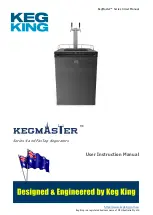2 - 3
INSTALLATION
JUNE 2021
32DSKF02.D
TITANIUM S-SERIES AND K-SERIES
PUBLIC USE SERVICE MANUAL
RSM0004800
CORRECT
BOWED UP
TIGHTEN HERE
LOOSE N HERE
TIGHTEN HERE
LOOSE N HERE
BOWED DOWN
FIGURE 2-3: FORD VAN CLAMPING BAR ARRANGEMENT
4.
LIFT INSTALLATION INTO BUSES
Refer to
Figure 2-9
. Clamping bars are used on most bus installations to help distribute floor loading, and should
only be cut if needed to clear a subframe member. A subframe member should be used to support clamping bar.
RSM0004500
12”
CLAMPING BAR
MINIMUM UNSUPPORTED
CLAMPING BAR LENGTH
CLAMPING BAR SUPPORTED BY
SUBFRAME WHERE POSSIBLE
SUBFRAME MEMBER
VEHICLE FLOOR
FIGURE 2-9: BUS CLAMPING BAR ARRANGEMENT
WARNING
LIFT WEIGHT IS APPROXIMATELY 400-425 LBS. TAKE EXTREME CARE WHEN POSITIONING BECAUSE
STEPWELL BRACKETS MAY TIP. THIS PROCEDURE MUST NOT BE ATTEMPTED BY ONE PERSON.
a.
Open doors fully and position lift so that it is centered in vehicle doorway. Close doors and move lift out-
ward until it clears doors by a minimum of ½”. The baseplate must be parallel to side of bus. Open manual
pump release valve (CCW) and allow folded platform to fully settle against latch on baseplate. Verify that
interference is not present between lift and doors. Reposition lift, if necessary. Close pump release valve;
do not over tighten valve.
b.
Refer
to
Figure 2-10
. Mark and drill ten 25/64" baseplate mounting holes (1 thru 10) through vehicle floor.


















